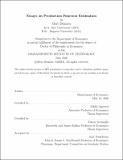Essays on production function estimation
Author(s)
Demirer, Mert.
Download1191625457-MIT.pdf (1.288Mb)
Other Contributors
Massachusetts Institute of Technology. Department of Economics.
Advisor
Nikhil Agarwal and Daron Acemoglu.
Terms of use
Metadata
Show full item recordAbstract
This first chapter develops a new method for estimating production functions with factor-augmenting technology and assesses its economic implications. The method does not impose parametric restrictions and generalizes prior approaches that rely on the CES production function. I first extend the canonical Olley-Pakes framework to accommodate factor-augmenting technology. Then, I show how to identify output elasticities based on a novel control variable approach and the optimality of input expenditures. I use this method to estimate output elasticities and markups in manufacturing industries in the US and four developing countries. Neglecting labor-augmenting productivity and imposing parametric restrictions mismeasures output elasticities and heterogeneity in the production function. My estimates suggest that standard models (i) underestimate capital elasticity by up to 70 percent (ii) overestimate labor elasticity by up to 80 percent. These biases propagate into markup estimates inferred from output elasticities: markups are overestimated by 20 percentage points. Finally, heterogeneity in output elasticities also affects estimated trends in markups: my estimates point to a much more muted markup growth (about half) in the US manufacturing sector than recent estimates. The second chapter develops partial identification results that are robust to deviations from the commonly used control function approach assumptions and measurement errors in inputs. In particular, the model (i) allows for multi-dimensional unobserved heterogeneity,(ii) relaxes strict monotonicity to weak monotonicity, (iii) accommodates a more flexible timing assumption for capital. I show that under these assumptions production function parameters are partially identified by an 'imperfect proxy' variable via moment inequalities. Using these moment inequalities, I derive bounds on the parameters and propose an estimator. An empirical application is presented to quantify the informativeness of the identified set. The third chapter develops an approach in which endogenous networks is a source of identification in estimations with network data. In particular, I study a linear model where network data can be used to control for unobserved heterogeneity and partially identify the parameters of the linear model. My method does not rely on a parametric model of network formation. Instead, identification is achieved by assuming that the network satisfies latent homophily - the tendency of individuals to be linked with others who are similar to themselves. I first provide two definitions of homophily: weak and strong homophily. Then, based on these definitions, I characterize the identified sets and show that they are bounded under weak conditions. Finally, to illustrate the method in an empirical setting, I estimate the effects of education on risk preferences and peer effects using social network data from 150 Chinese villages.
Description
Thesis: Ph. D., Massachusetts Institute of Technology, Department of Economics, May, 2020 Cataloged from the official PDF of thesis. Includes bibliographical references (pages 193-201).
Date issued
2020Department
Massachusetts Institute of Technology. Department of EconomicsPublisher
Massachusetts Institute of Technology
Keywords
Economics.